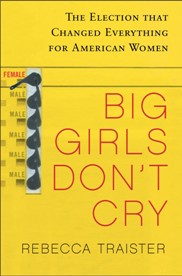
Rebecca Traister followed Hillary Clinton’s 2008 campaign from its beginnings for Salon magazine. But it wasn’t until Clinton was out of the running – and when John McCain chose Sarah Palin as his running mate – that Traister began to see the story that would become Big Girls Don’t Cry: The Election that Changed Everything for American Women. “What became clear to me was that this was an epic story about women’s history and American politics and the presidency, one that had shadows that extended back to the founding of this country, and one that was obviously going to change the future,” Traister said. Below, Traister talks with Zócalo about why 2008 was a landmark year for American women, where feminism stands today, and what the future holds for female candidates.
Q. You start your book off with a quote from Hillary Clinton’s speech at her graduation. How does her life story fit into the story of American feminism, and how does she represent the movement?
 A. I don’t think any one person represents American feminism. The idea that a women’s movement, either local or broad, is cohesive is a false one. Any women’s movement includes women of so many diverse experiences, races, and sexualities. So I wouldn’t say Hillary represents American feminism. I do think she is a crucial part of the feminist story in the U.S., especially in recent history. First and foremost, she is the first woman to get anywhere close to a presidential nomination. That is stunning. The only person who preceded her was Shirley Chisholm in 1972, whose campaign was largely symbolic. Geraldine Ferraro was nominated for vice president, which is very different, and she lost in spectacular fashion with Walter Mondale. But Hillary’s nomination was treated as inevitable. We talk about it in a dry, electoral way, and blame that attitude for her ultimate loss – we say she was too overconfident. But it’s mind-blowing that any woman was ever considered inevitable for her party’s nomination. No one had ever done it before. It was so far from inevitable, and none of us saw that at the time.
A. I don’t think any one person represents American feminism. The idea that a women’s movement, either local or broad, is cohesive is a false one. Any women’s movement includes women of so many diverse experiences, races, and sexualities. So I wouldn’t say Hillary represents American feminism. I do think she is a crucial part of the feminist story in the U.S., especially in recent history. First and foremost, she is the first woman to get anywhere close to a presidential nomination. That is stunning. The only person who preceded her was Shirley Chisholm in 1972, whose campaign was largely symbolic. Geraldine Ferraro was nominated for vice president, which is very different, and she lost in spectacular fashion with Walter Mondale. But Hillary’s nomination was treated as inevitable. We talk about it in a dry, electoral way, and blame that attitude for her ultimate loss – we say she was too overconfident. But it’s mind-blowing that any woman was ever considered inevitable for her party’s nomination. No one had ever done it before. It was so far from inevitable, and none of us saw that at the time.
The story of Hillary’s run is important for a million different reasons. Her attitude going in, the campaign staff and leadership she chose, her moves to the center, her behavior in the Senate, the way she cooperated so well with her colleagues – all this stuff that critics assailed her about were tied up with the fact that she was maneuvering to do something no woman had done. That’s not to excuse what we disagree with her about. It’s not to say it was okay for her to vote in favor of the Iraq war. But we can’t deny who Hillary was. She had been for 20 years a groundbreaking person in the American consciousness, in part because she was a groundbreaking woman. Her strategic choice in the campaign to disguise her femininity was born of decades of assumptions about how we would greet a female candidate. Her decision to stay in the race despite the fact that everyone was pushing her to get out – that tells a story about how we have long regarded women pursuing power. She was defying people, refusing to do what the male establishment was telling her to do. As she was doing that, her coalition was growing stronger. It was exhilarating for me not because I thought Hillary was going to win or should win – it was just that she was completely expanding our minds about how a woman might behave.
Q. Have our attitudes about women pursuing power changed since 2008? Are we much more open to it?
A. They have changed since 2008. I don’t know that they’ve radically altered. This country has long held competitive, ambitious women, and certainly women who threaten those in power – usually men, often white men – with disdain. They’re desexualized, talked about as if they were unattractive and mannish, demonized them. You can see that in how people talked about Hillary, particularly when they compared her to Glenn Close’s character in fatal attraction. When women behave in a way we think of as “male”, it’s monstrous to some people. But Hillary and Sarah Palin, who I disagree with on every front possible, push the boundaries about how women are supposed to behave. They’re independent and stubborn and defy conventional wisdom. There are now many more models for competitive femininity, we can celebrate it now. It won’t be such a surprise the next time a woman refuses to get out of race. It doesn’t mean there won’t be sexism and irritation. But it won’t be such a shock.
Q. Much of the sexism we saw in 2008 seemed particularly ugly – why was it so, was it just the fact of having female candidates?
A. It was particularly nasty because it was particularly unusual to see women in these positions. I think we sometimes pat ourselves on the back and say we’re post-race and post-gender, we’ve worked it all out. That’s not true. There would be no way the first female presidential candidate wouldn’t meet sexist resistance. It’s just not possible. The fact that it surprised many people reflects on the way we like to convince ourselves that we’re further along than we really are. I didn’t see what happened to Hillary or to Sarah Palin as a step back, as many did. I saw it as lifting a curtain on what is still bubbling underneath. Only by exposing it can we hope to move through it.
As for the future, of course, we have to remind ourselves that we didn’t solve racism by electing Barack Obama. He continues to face racism of an ugly, terrifying and distressing nature. The next woman who runs for president will face sexism. The first openly gay person to run will face homophobia. Do I think it will be better for the next woman? In some ways, we’ll see a repeat of 2008, but we’ll have a more open conversation about it, a higher sensitivity, a more open dialogue, and more of a vocabulary for dealing with it. It won’t be this stunned reaction. A big part of it, too, is the extended roles for women in the media. When we have expanded roles not only for leaders but for the people who cover those leaders, then we have a more diverse range of opinions.
Q. Where do conservative women fit into feminism?
 A. “Feminist” is ultimately a construction of language. There’s no policed group. Anybody who wants to call themselves a feminist gets to be one. I can’t tell anybody they can’t be a feminist. Feminism has always represented many diverse interests – it has always been a mash-up of competing ideas, ideologies, perspectives. What being a feminist gets you is participation in a conversation in which you may well be told your ideas are anti-woman or anti-feminist. That’s what we have now.
A. “Feminist” is ultimately a construction of language. There’s no policed group. Anybody who wants to call themselves a feminist gets to be one. I can’t tell anybody they can’t be a feminist. Feminism has always represented many diverse interests – it has always been a mash-up of competing ideas, ideologies, perspectives. What being a feminist gets you is participation in a conversation in which you may well be told your ideas are anti-woman or anti-feminist. That’s what we have now.
Q. Is that an important conversation to have?
A. Absolutely. Feminism – or the women’s movement, or womanism, whatever people choose to call it – can’t get stuck, for instance, in the 1970s, in second-wave feminism. It has to grow, and it has to have that conversation. This is my personal belief: I would say to those on the socially conservative right who are calling themselves feminists that I don’t believe it’s in the interest of women to oppose, for instance, reproductive rights. It’s not just about abortion. It’s about limiting the choices of other women. When you limit their choices, you limit their equal participation economically, socially, politically, professionally. I don’t think feminism needs to expand to include anti-reproductive-rights views, but we have to tackle these questions. Any movement is only as strong as what it can talk about. If we’re paralyzed by this question, we’re a weak movement. This incursion – which is absolutely allowable – gives feminists the opportunity to strengthen their expressions of belief in what feminism means.
Q. How was Michelle Obama treated in 2008 – where did she fit into this narrative?
A. She had a rough road. She entered the race a brilliant, outspoken, dynamic, vibrant candidate for First Lady. She met with an enormous amount of resistance that resembled what Hillary received in 1992. In Obama’s case, it was racialized. Her opposition very quickly portrayed her in extremely stereotyped ways as the angry black woman. People were completely unapologetic about this. Christopher Hitchens, in an article for Slate about her senior college thesis, falsely tied her to the Black Power movement. She was lampooned on the cover of the New Yorker. She was on the cover of every magazine with headlines like, “Why is Michelle Obama so Angry?” and “Mrs. Grievance.” It was terrible what happened to her. And many of the people who should have been defending her didn’t. The feminists who had done hard work on Hillary’s behalf were not speaking up for Michelle.
She got made over partly through the campaign. She dropped out. Her image got so tamed. She went on “The View” to talk about her clothes and pantyhose. She went to the Democratic Convention and spoke only as a familial extension of others – as a daughter, a mother, a wife. It’s perfectly authentic, her family ties and her commitment to her marriage, it’s not as though it was fake. But all parts of her were stripped off. I think we still see that in the way she’s presented in the White House. I cannot fathom how she feels about any of this. She may be fine with it; she may hate it. This is more about my dismay with public tastes for what symbolic womanhood needs to look like for us to want it. In order to love our First Lady, it seems, her ambition, her independence, her political believes, her opinions about her country, all must be obscured. She has to be presented as the safest, most traditional model of feminine qualities. She has to be tied to gardening, motherhood, the kitchen.
*Photo of Rebecca Traister by Sarah Karnasiewicz. Photo of Hillary Clinton at a 2008 rally in North Carolina courtesy Russell Harrison.




Send A Letter To the Editors